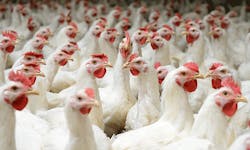GAO: Safety in Meat and Poultry Industries Better But Need More Improvement
Although injury and illness rates in the meat and poultry processing industries have declined in recent years – similar to rates in all U.S. manufacturing – the rates continue to be higher than rates for manufacturing overall, according to the report “Workplace Safety and Health: Additional Data Needed to Address Continued Hazards in the Meat and Poultry Industry,” from the Government Accountability Office (GAO).
Injury rates in meat and poultry processing declined from an estimated 9.8 cases per 100 full-time workers in 2004 to 5.7 in 2013. Meat workers sustained a higher estimated rate of injuries and illnesses than poultry workers, according to DOL data.
Centers for Disease Control and Prevention (CDC) evaluations and academic studies have found that workers continue to face the same hazardous conditions GAO cited in 2005, including tasks associated with musculoskeletal disorders, exposure to chemicals and pathogens and traumatic injuries from machines and tools.
DOL faces challenges gathering data on injury and illness rates for meat and poultry workers because of underreporting and inadequate data collection. For example, workers may underreport injuries and illnesses because they fear losing their jobs, and employers may underreport because of concerns about potential costs. Another data gathering challenge is that DOL only collects detailed data for those injuries and illnesses that result in a worker having to take days away from work. These detailed data do not include injuries and illnesses such as musculoskeletal disorders that result in a worker being placed on work restriction or transferred to another job.
Further hampering efforts to get the full picture of injuries in the industry, DOL does not have complete injury and illness data on meat and poultry sanitation workers because they may not be classified in the meat and poultry industry if they work for contractors.
According to GAO: “Federal internal control standards require agencies to track data to help them make decisions and meet their goals. These limitations in DOL’s data collection raise questions about whether the federal government is doing all it can to collect the data it needs to support worker protection and workplace safety.”
DOL, the U.S. Department of Agriculture and the CDC concurred with GAO’s recommendations.
The National Chicken Council, National Turkey Federation and U.S. Poultry & Egg Association released a statement following publication of the GAO report that says in part: “Our employees are our most important asset and their safety is of paramount importance.”
The groups said they fully cooperated with GAO for more than a year, through stakeholder interviews and processing plant visits, as GAO worked on the report. “We are pleased to see the report emphasizes the fact that injuries and illnesses have decreased dramatically in the poultry processing industry over the past several years,” said the statement.
The groups have their own sets of statistics, which casts a favorable light on the industry. “The incidence of occupational injuries and illnesses within the poultry sector’s slaughter and processing workforce has fallen by 81 percent in the last 20 years and continues to decline according to the 2014 Injury and Illness Report released by the Department of Labor’s Bureau of Labor Statistics (BLS),” the groups claimed. “In fact, poultry processing’s injury and illness rate of 4.3 is on par with all manufacturing jobs (4.0) and is decreasing at a much faster rate. When comparing apples to apples, poultry processing’s rate is much lower than all food manufacturing in general.”
Sarah Rich, a staff attorney for the Southern Poverty Law Center (SPLC), takes a different view of the report’s findings.
“It’s clear from the report that workers continue to put their health and well-being on the line to fulfill the meat and poultry industry's relentless production demands,” said Rich. “Their injury and illness rates still outpace the rates for manufacturing overall despite the GAO acknowledging that there is ‘underreporting and inadequate data collection’ for injuries and illness in the meat and poultry industry.”
She added, “There should be no doubt that the industry will continue to sacrifice people for profit until there’s regulation to reduce the grueling speed of the processing lines and ensure workplace injuries are properly addressed. It is time to end the exploitation.”
The SPLC investigated the conditions in Alabama poultry plants in its report, “Unsafe at These Speeds.” The SPLC’s work also led to a Wayne Farms poultry processing plant in Alabama being fined more than $100,000 by OSHA in 2014 over unsafe and abusive conditions.
About the Author

Sandy Smith
Sandy Smith is the former content director of EHS Today, and is currently the EHSQ content & community lead at Intelex Technologies Inc. She has written about occupational safety and health and environmental issues since 1990.
